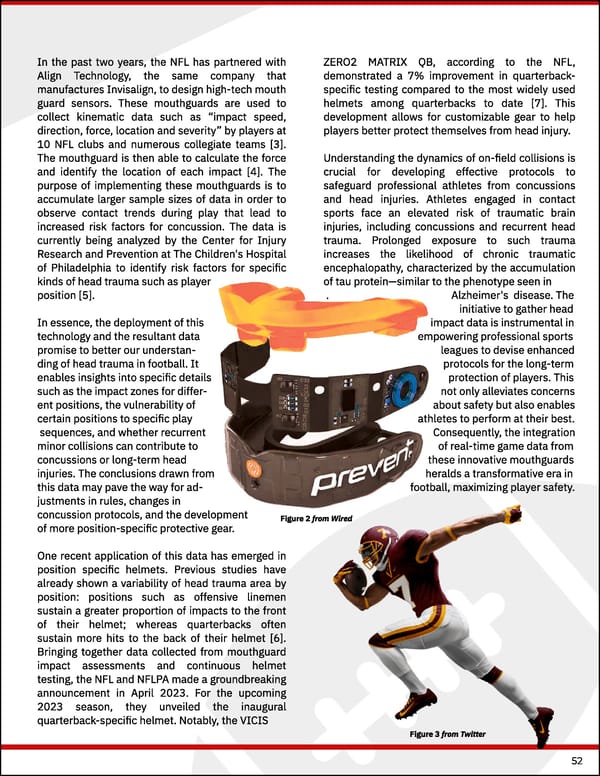In the past two years, the NFL has partnered with ZERO2 MATRIX QB, according to the NFL, Align Technology, the same company that demonstrated a 7% improvement in quarterback- manufactures Invisalign, to design high-tech mouth speci昀椀c testing compared to the most widely used guard sensors. These mouthguards are used to helmets among quarterbacks to date [7]. This collect kinematic data such as “impact speed, development allows for customizable gear to help direction, force, location and severity” by players at players better protect themselves from head injury.ꨀ 10 NFL clubs and numerous collegiate teams [3]. Understanding the dynamics of on-昀椀eld collisions is The mouthguard is then able to calculate the force crucial for developing effective protocols to and identify the location of each impact [4]. The safeguard professional athletes from concussions purpose of implementing these mouthguards is to and head injuries. Athletes engaged in contact accumulate larger sample sizes of data in order to sports face an elevated risk of traumatic brain observe contact trends during play that lead to injuries, including concussions and recurrent head increased risk factors for concussion. The data is trauma. Prolonged exposure to such trauma currently being analyzed by the Center for Injury increases the likelihood of chronic traumatic Research and Prevention at The Children's Hospital encephalopathy, characterized by the accumulation of Philadelphia to identify risk factors for speci昀椀c of tau protein—similar to the phenotype seen in kinds of head trauma such as player . Alzheimer's disease. Th攀 position [5].ꨀ . . initiative to gather head In essence, the deployment of this impact data is instrumental i渀 technology and the resultant data empowering professional sports promise to better our understanⴀ leagues to devise enhanced ding of head trauma in football. It protocols for the long-term enables insights into speci昀椀c details protection of players. This such as the impact zones for differⴀ not only alleviates concerns ent positions, the vulnerability of about safety but also enables certain positions to speci昀椀c pla礀 athletes to perform at their best. sequences, and whether recurren琀 Consequently, the integration minor collisions can contribute to of real-time game data from concussions or long-term head these innovative mouthguards injuries. The conclusions drawn from heralds a transformative era in this data may pave the way for adⴀ football, maximizing player safety⸀ justments in rules, changes in concussion protocols, and the development Figure 2 from Wired of more position-speci昀椀c protective gear㠀 One recent application of this data has emerged in position speci昀椀c helmets. Previous studies have already shown a variability of head trauma area by position: positions such as offensive linemen sustain a greater proportion of impacts to the front of their helmet; whereas quarterbacks often sustain more hits to the back of their helmet [6]. Bringing together data collected from mouthguard impact assessments and continuous helmet testing, the NFL and NFLPA made a groundbreaking announcement in April 2023. For the upcoming 2023 season, they unveiled the inaugural quarterback-speci昀椀c helmet. Notably, the VICIS ᐀㐀 Figure 3 from Twitter 52
 Penn Healthcare Review Fall 2023 Journal— Sports Medicine Page 56 Page 58
Penn Healthcare Review Fall 2023 Journal— Sports Medicine Page 56 Page 58